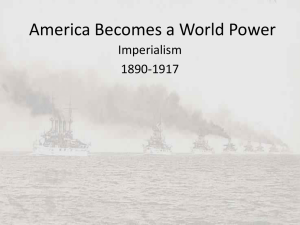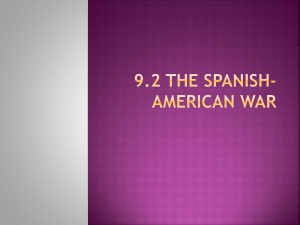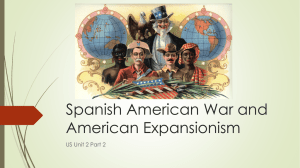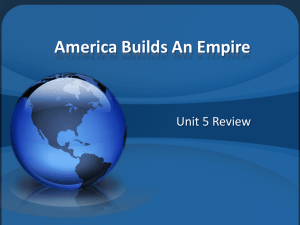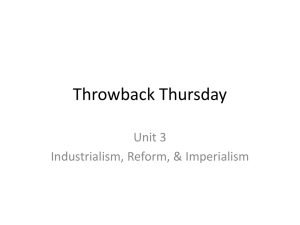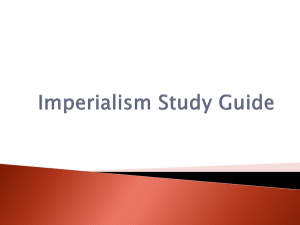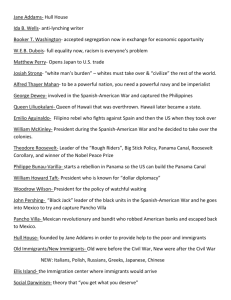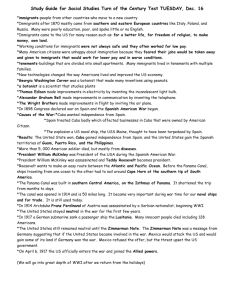"America Claims an Empire"
advertisement
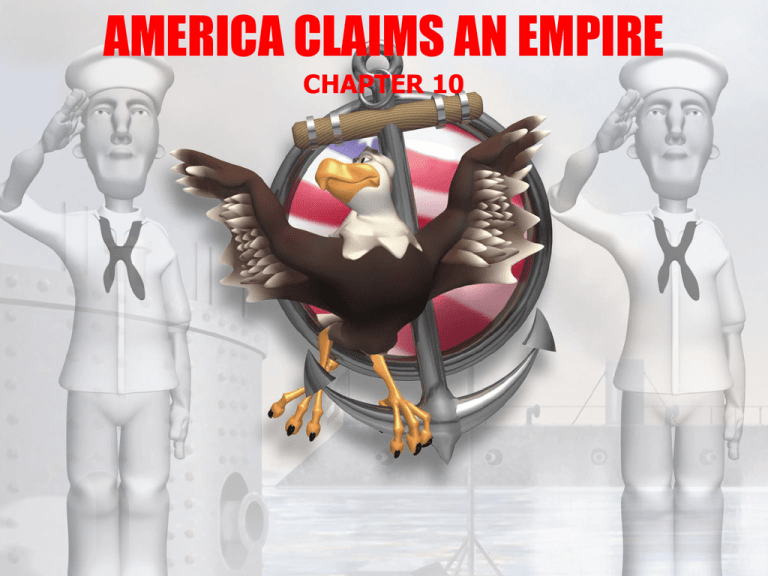
AMERICA CLAIMS AN EMPIRE CHAPTER 10 IMPERIALISM AND AMERICA • Throughout the 19th century America expanded control of the continent to the Pacific Ocean • • By 1880, many American leaders felt the U.S. should join European nations and establish colonies overseas Thus began America’s foray into Imperialism – the policy in which stronger nations extend their economic, political, or military control over weaker territories. WHY IMPERIALISM • Desire for Military strength • Leader of US Navy Alfred Mahan advised strong navy • Battleships such as the Maine and Oregon transformed the country into the world’s third largest naval power • Thirst for new markets • to spur economy & trade (needed raw materials) • Belief in Cultural Superiority • a belief that Anglo-Saxons were superior THE U.S. ACQUIRES ALASKA • In 1867, Secretary of State William Steward arranged for the United States to buy Alaska from the Russians for $7.2 million • Some thought it was a silly idea and called it “Steward’s Icebox” • Time has shown how smart it was to buy Alaska for 2 cents an acre • Alaska is rich in timber, minerals and oil • • • • U.S. TAKES HAWAII Hawaii had been economically important to Americans for centuries To avoid import taxes (tariffs), sugar growers pleaded for annexation The U.S. knew the value of the Islands – they had built a naval base at Pearl Harbor in 1887 Led by Sanford Dole, American annexed Hawaii in 1898 and it formally became a state in 1959 MCKINLEY WHAT HAPPENED TOWILLIAM HAWAII? SANFORD B. DOLE • • • • Queen Liliuokalani agenda was Hawaii for Hawaiians. She proposed property owning qualifications for voting To prevent this from happening business owners and US ambassador organized a revolution With the help of the Marines they overthrew the government and set up a government headed by Sanford B. Dole President William McKinley declared Hawaii a territory of the united states without ever letting Hawaiians a chance to vote on it Section 2: Spanish American War • •• • • Spain once the most powerful country on earth now only has two colonies left. Cuba and the Philippines. America had long held an interest in Cuba U.S tried to buy Cuba from the Spanish. Spain responded “I rather see Cuba sunk in the ocean” When Cubans unsuccessfully rebelled against Spanish rule in the late 19th century, American sympathy went out to the Cuban people After Spain abolished slavery in Cuba in 1886, Americans invested millions in Cuban sugar CUBA’S SECOND WAR FOR Weyler to •Spain sent Valeriano INDEPENDENCE Cuba to restore order. Anti-Spain sentiment in Cuba soon erupted into a second war for independence •He tried to restore order by Led by poet Jose Marti, putting civilians in Cuba attempted a revolution in 1895 concentration camps. Marti deliberately destroyed property, including American sugar plants, hoping to provoke American intervention •Over 300,000 Cubans were put in these camps where many died of disease and starvation. Marti WAR FEVER ESCLATES • Newspaper publishers • William Randolph Hearst (New York Journal) • Joseph Pulitzer (New York World) • exaggerated Spanish atrocities and brutality in “Headline Wars” Political cartoon: Pulitzer (left) and Hearst escalating and instigating war between the U.S. and Spain YELLOW JOURNALISM • The style of writing when you exaggerate the news to lure and engage readers U.S.S MAINE EXPLODES Before • Early in 1888, President McKinley ordered the U.S.S. Maine to Cuba in order to bring home American citizens in danger After • On February 15, 1898 the ship blew up in the harbor of Havana • More than 260 men were killed The Maine Explodes Unknown artist , 1898 Notice the men flying dramatically through the air. •Congress debated WAR ERUPTS WITH SPAIN • for a week and then finally gave• the ok for a declaration of war on Spain. • There was no holding back those that wanted war with Spain Newspapers blamed the Spanish for bombing the U.S.S. Maine (recent investigations have shown it was a fire inside the Maine) “Remember the Maine!” became a rallying cry for U.S. intervention in Cuba • It made no difference that Spain agreed to all the US demands THE WAR IN THE PHILIPPINES • U.S. forces surprised • • • • Spain by attacking the Spanish colony of the Philippines Commodore George Dewey gave the command to open fire on Spanish ships Dewey’s men destroyed every Spanish ship there. 11,000 Americans joined forces with Filipino rebel leader Emilo Aguinaldo By August, 1898 Spain had surrendered to the U.S. in Manila · The Philippine capital, Manila, was captured with the help of Filipino rebels, led by Emilio Aguinaldo. THE WAR IN THE CARIBBEAN • A naval blockade of • Cuba was followed by a land invasion highlighted by Roosevelt’s Rough Rider victory at San Juan Hill Next, the American Navy destroyed the Spanish fleet and paved the way for an invasion of Puerto Rico (Spanish colony) About the Soldiers • More than 125,000 Americans volunteered • The training camps lacked adequate supplies and effective leaders • Not enough modern guns to go around • Troops were outfitted with heavy woolen uniforms unsuitable for Cuba’s tropical climate soldiers died ofmany yellow fever ThereMany were also African during their stay in Cuba some 2,000 American regiments soldiers died of disease more than was killed in actual combat · Theodore Roosevelt led a volunteer Cavalry regiment known as the Rough Riders to victory at the battle of San Juan Hill. Col Roosevelt in Rough Rider uniform. October 26, 1898 Theodore Roosevelt and the Rough Riders atop San Juan Heights, 1898 · Spain surrendered after their fleet was destroyed two days later in Santiago Bay. The torpedo was a new, highly feared weapon system which saw very little use during the war. In spite of all of the amazing claims of its abilities, the Spanish American War saw no vessel on either side sunk through the use of a torpedo. However, at the battle of Santiago, the Spanish cruiser VIZCAYA apparently suffered a torpedo hit, putting the ship out of action. U.S. WINS; SIGNS TREATY OF PARIS The U.S. and Spain signed an armistice on August 12, 1898, ending what Secretary of State John Hay called “a splendid little war” The war lasted only 16 weeks Cuba was now independent U.S. receives Guam, Puerto Rico, and “bought” the Philippines for $20 Treaty of Paris, 1898 Results of the War "The war of the United States with Spain was very brief. Its results were many, startling, and of world-wide meaning." --Henry Cabot Lodge 1. Cuba was given its independence. 2. The U.S. was given control of the islands of Puerto Rico, Guam and the Philippines. 3. Spain received $20 million dollars. · Cuba was forced to sign the Platt Amendment, which: - limited Cuba’s right to make treaties and borrow money - allowed the U.S. to intervene in Cuba - gave the U.S. control of the naval base in Guantanamo Bay “School Begins” - In the back of the classroom students representing California, Texas, Arizona, New Mexico and Alaska are quietly reading. In the front row are boys representing the Philippines, Puerto Rico, Cuba, and Hawaii looking as if they would rather not be there. “The American Policy” Miss Columbia, teacher at the Liberty School, is ringing a bell. Uncle Sam, switch in hand, is dragging by the ear a Filipino boy in loincloth and amulet. Boys from Hawaii, Cuba, and Puerto Rico are standing around watching. SECTION 3: ACQUIRING NEW LANDS • The U.S had to decide how to rule the new lands • • • Puerto Rico wanted their independence– but the U.S. had other plans Puerto Rico was important to the U.S. strategically The U.S. set up a civil government, full citizenship, and a bicameral system FILIPINOS REBEL • • • U.S. troops fire on rebels Filipinos reacted with rage to the American annexation Rebel leader Emilio Aguinaldo vowed to fight for freedom and in 1899 he led a rebellion The 3-year war claimed 20,000 Filipino rebels, 4,000 American lives and $400,000,000 (20x the price the U.S. paid for the land) AFTERMATH OF THE WAR • • • • After the war US set up a government similar to the one in Puerto Rico The US president would appoint a governor and a legislatures Filipinos would elect the lower house Under American rule the Philippines moved gradually toward independence and finally became and independent republic on July 4, 1946 FOREIGN INFLUENCE IN CHINA • Foreign nations were opening the door to China’s trade • • • China was a vast potential market for American products Weakened by war and foreign intervention, many European countries had colonized in China China was known as “sick man of Asia” France, Germany, Britain, Japan, and Russia have all set up prosperous settlements along the coast of china. In 1889, John Hay, U.S. Secretary of State, issued the Open Door Policy which outlined his plan for free trade among nations in China • BOXER REBELLION • • European nations dominated China’s cities Resentment arose in the form of secret societies determined to rid China of these “foreign devils” The Boxer’s were a secret group that rioted in 1900, killing and vandalizing all things foreign. • • • Killed Chinese who converted to Christianity Called boxers because they practice martial Arts Germany, France, Great Britain and American troops marched on the capital and put down the “Boxer Rebellion” SECTION 4: AMERICA AS A WORLD POWER • The assassination of William McKinley gave Teddy Roosevelt the presidency • Two events signaled America’s continued climb toward being the #1 world power • The Nobel Peace Prize is awarded annually • • 1)Roosevelt negotiated a settlement between Russia and Japan who had been at War 1)Construction of Panama Cana Roosevelt won the 1906 Nobel Peace Prize BUILDING THE PANAMA CANAL 1904-1914 • The French had already unsuccessfully attempted to build a canal through Panama • • Cost- $380 million Workers– Over 40,000 (5,600 died) Time – Construction took 10 years • America first had to help Panama win their independence from Colombia – which it did Construction of the Canal stands as one of the greatest engineering feats of all-time Teddy Roosevelt said “the Dirt Will Fly” Animation: How the Panama Canal Works Panama Canal Timelapse Panama Canal • France, led by engineer Ferdinand de Lesseps, began construction on the canal in 1881. • About $287,000,000 had been spent and 20,000 men had died, mostly of yellow fever and malaria, before the French gave up. Ferdinand de Lesseps • President Theodore Roosevelt stated in a speech about the Panama Canal, "No single great material work which remains to be undertaken on this continent is as of such consequence to the American people." • Colombia refused to grant the U.S. permission to complete the canal project. • Therefore, the U.S. encouraged the Panamanian people to revolt against Colombia. • On November 3, 1903, Panama declared their independence from Colombia and allowed the U.S. to build the canal. •U.S Paid Panama $10 million plus an annual rent of $250,000 for an area called the canal zone • U.S. workers first sprayed tons of insecticide across Panama in order to destroy the mosquito eggs in an attempt to limit cases of malaria and yellow fever. 1905 fumigation car eradicating the mosquitoes - Panama City • Using mainly black workers from the West Indies, the U.S. finished the canal in 1914. •Was overshadowed by the beginning of WWI 1909 Arrival of SS. Ancon with 1500 laborers from Barbados at the Cristobal Port in Colon, Panama The Panama Canal – Live Cameras TR in Panama (Construction begins in 1904) This view, provided by NASA, shows the thin blue line (canal) cutting across the middle of Panama Almost 1,000,000 ships have passed through the canal, which became sole property of Panama in the year 2000 Monroe Doctrine Constable of the World Policing Latin America Roosevelt Corollary • claimed the right of the U.S. to intervene in Latin America to preserve law and order • extension of the Monroe Doctrine • established by Pres. Roosevelt in 1904 * The U.S. used the Roosevelt Corollary frequently, angering Latin American countries. Dollar Diplomacy – President Taft’s policy of encouraging Americans to invest in Latin America U. S. Global Investments & Investments in Latin America, 1914 Country Occupied Years Reasons Dominican Republic 1916 - to control their 1924 finances, help them pay their debts, and keep the peace Nicaragua 1912 - to restore order after 1933 a revolution and to protect U.S. businesses Haiti 1915- to restore order after 1934 years of anarchy Honduras 1911 - to protect U.S. 1925 businesses during civil war Porfirio Diaz Mexican Revolution Francisco Madero •Military dictator Porfirio Diaz a friend of the United States ruled Mexico for 30 years Huerta encourage American investment •Was overthrown by Francisco Madero… was not able to satisfy Mexican citizens •Was killed and General Victoriano Huerta took his place •President Wilson refused to recognize Huerta’s new government Troubles in Mexico • Wilson waited for an exucse to occupy Mexico and take down Huerta. •Mexico arrested several U.S. sailors in 1914 and Pres. •Wilson sent the navy to occupy Veracruz. "Formal raising of first flag of U.S. / Veracruz 2 P.M. April 27, 1914" Generals Alvaro Obregon, Pancho Villa and John J. Pershing, Ft. Bliss, El Paso, Texas, Aug. 27, 1914. • In 1916, Mexican Gen. Pancho Villa killed 18 Americans at the Santa Ysabel massacre and 17 Americans in Columbus, New Mexico. Pancho Villa’s 1916 attack on Columbus, New Mexico After the raid on Columbus, N.M. • U.S. General John Pershing was sent to Mexico in an unsuccessful attempt to capture Villa. Statue of Pancho Villa, La Buffa, Mexico •Pancho Villa was never found. •The United States grew closer to war with Mexico over government and land occupation •Facing and increasing risk of war in Europe both sides backed down judging they needed to keep their border relations friendly. •During the start of the 20 th United States century the •Expanded its foreign markets •Built a modern navy •Exercised its international police power to ensure dominance in Latin America
